Impact of Environmental Exposure Conditions on the Maintenance of Facades’ Claddings
Abstract
1. Introduction
2. Materials and Methods
2.1. Constructive Solutions Analyzed
2.2. Maintenance Model
- Sw is the severity of degradation (in percentage);
- An the area affected by anomaly n (in m2);
- kn the multiplication factor for the anomaly n;
- ka,n the weighting coefficient according to the relative weight of the anomaly n;
- A the total area of the constructive solution (in m2); and
- k the multiplying factor corresponding to the highest degradation condition of the area A.
- Service life: The end of the service life (ESL) is predicted through the cumulative distribution functions (CDF) computed in the degradation process [36]. It is assumed that the ESL of the constructive solutions is reached when the probability of transition between degradation conditions C and D is equal to 50%. This value was defined based on previous works [7] and experts’ judgment.;
- Life-cycle costs: The life-cycle costs (LCC), defined by Equation (2), correspond to the sum of the construction costs (production and application), Cinitial, the costs related with inspections, ∑Cinspection,t, and the costs related with other maintenance activities, ∑Cmaintenance,t. Basically, LCC represents the accumulate costs that the owner/manager will incur during the time horizon, th, to keep the cladding in operation [45].To contemplate future investments, Equations (3) and (4) are used to compute the net present value of the inspection and maintenance activities, respectively [46,47].where Cinspection and Cmaintenance are inspection and maintenance activity costs at time t, respectively, and υ the real discount rate. In this study, a private sector environment is considered, and therefore, a real discount rate of 6% is adopted [45,48];
- Efficiency index: The ability of a maintenance strategy to maintain the cladding in a good performance condition (in terms of degradation) is described by the efficiency index (EI)—Equation (5).where ∫ Sw(t) dt represent the area underneath the degradation profile (loss of performance), and 100∙th the area underneath the degradation profile when there is no degradation (theoretical situation). The efficiency index ranges between 0 and 1. The higher the EI value, the more efficient the maintenance strategy is over time;
- Number of interventions: The number of interventions represents the average number of times that the different interventions (cleaning operations, minor interventions, and total replacement) are carried out in the cladding during the period under analysis.
2.3. Multi-Criteria Decision Analysis
2.4. Environmental Exposure Conditions
2.4.1. Exposure to Damp
2.4.2. Distance from the Sea
2.4.3. Orientation
3. Results
- MS1: Total replacement only;
- MS2: Combination of minor interventions and total replacement; and
- MS3: Combination of cleaning operations, minor interventions, and total replacement.
3.1. Analysis without the Impact of Environmental Exposure Conditions
3.2. Exposure to Damp
3.3. Distance from the Sea
3.4. Orientation
- If only the situation without maintenance is analyzed, CTS facing south has the shortest service life and the remaining orientations have similar values. Thus, the direct incidence of solar radiation has a significant impact on the durability of this constructive solution. However, if the impact of cleaning operations and minor interventions is analyzed, it seems that this type of actions has a greater impact on claddings facing south and a lower impact on those facing north;
- For NSC, the west orientation is the one with the shortest service life for all maintenance strategies and the south orientation is the one with the longest service life for all maintenance strategies. For MS1, the service life of the south, east and north orientations is similar. However, for maintenance strategies more complete, the south orientation presents higher service lives (Figure 13) for, approximately, the same maintenance costs (Figure 14), number of replacements (Figure 16) and efficiency indexes (Figure 15) when compared with other orientations;
- Finally, for ACF, facades facing south have shorter service lives (for MS1), showing that direct incidence of solar radiation has a significant impact on the degradation of facades. In other words, direct incidence of solar radiation tends to increase the surface damage and cracking due to thermal gradients [40]. However, it is also found that cleaning operations and minor interventions have a significant impact on facades with this orientation (at least, compared to facades north oriented). On the other hand, facades facing east have a longer service life.
3.5. Multi-Criteria Decision Analysis
4. Discussion
5. Conclusions
Author Contributions
Funding
Institutional Review Board Statement
Informed Consent Statement
Data Availability Statement
Conflicts of Interest
Appendix A
| Degradation Condition | Anomalies | ka,n | % Area Affected | Severity of Degradation (%) | |
|---|---|---|---|---|---|
| A (kn = 0) | No visible degradation | - | - | Sw ≤ 1 | |
| B (kn = 1) | Visual or surface degradation | Surface dirt | 0.25 | ≤10 | 1 < Sw ≤ 6 |
| Small surface craters/wear or scratches/crushing or scaling of the borders/change of shine and/or color/damp stains | 0.60 | ≤10 | |||
| Cracking | Cracked glazing | 0.25 | - | ||
| Markedly orientated cracking (<0.2 mm) b without leakage a | 1.00 | - | |||
| Joint deterioration | Staining or change in color | 0.25 | - | ||
| C (kn = 2) | Visual or surface degradation | Small surface craters/wear or scratches/crushing or scaling of the borders/change of shine and/or color/damp stains | 0.60 | >10 and ≤50 | 6 < Sw ≤ 20 |
| Biological growth/efflorescence | 1.00 | ≤30 | |||
| Cracking | Cracking with no predominant direction Markedly orientated cracking (>0.2 mm) c without leakage a | 1.00 | ≤30 | ||
| Joint deterioration | Without loss of filling material | 1.00 | ≤30 | ||
| With loss of filling material | 1.50 | ≤10 | |||
| Detachment | Loss of adherence Swelling | 1.50 | ≤20 | ||
| D (kn = 3) | Visual or surface degradation | Small surface craters/wear or scratches/crushing or scaling of the borders/change of shine and/or color/damp stains | 0.60 | >50 | 20 < Sw ≤ 50 |
| Biological growth/efflorescence | 1.00 | >30 | |||
| Cracking | Cracking with no predominant direction Markedly orientated cracking (>1 mm) d without leakage a | 1.00 | >30 and ≤50 | ||
| Joint deterioration | Without loss of filling material | 1.00 | >30 and ≤50 | ||
| With loss of filling material | 1.50 | >10 and ≤30 | |||
| Detachment | Loss of adherence Swelling | 1.50 | >20 | ||
| Localized detachment | 2.00 | ≤10 | |||
| E (kn = 4) | Cracking | Cracking with no predominant direction Markedly orientated cracking (>5 mm) e | 1.00 | >50 | Sw > 50 |
| Joint deterioration | Without loss of filling material | 1.00 | >50 | ||
| With loss of filling material | 1.50 | >50 | |||
| Detachment | Generalized detachment | 2.00 | >10 | ||
| Degradation Condition | Anomalies | ka,n | % Area Affected | Severity of Degradation (%) | |
|---|---|---|---|---|---|
| A (kn = 0) | No visible degradation | - | - | Sw ≤ 1 | |
| B (kn = 1) | Visual or surface degradation anomalies | Surface dirt | 0.13 | >10 | 1 < Sw ≤ 8 |
| Moisture stains/localized stains/color change | 0.13 | ≤15 | |||
| Flatness deficiencies | 0.13 | ≤10 | |||
| Loss-of-integrity anomalies | Material degradation * ≤1% plate thickness | 1.00 | - | ||
| Material degradation * ≤10% plate thickness | 1.00 | ≤20 | |||
| C (kn = 2) | Visual or surface degradation anomalies | Moisture stains/localized stains/color change | 0.13 | >15 | 8 < Sw ≤ 20 |
| Moss, lichen, algae growth/parasitic vegetation/efflorescence | 0.13 | ≤30 | |||
| Flatness deficiencies | 0.13 | >10 and ≤50 | |||
| Joint anomalies | Joint material degradation | 0.25 | ≤30 | ||
| Material loss—open joint | 1.00 | ≤10 | |||
| Bond-to-substrate anomalies | Scaling of stone near the edges Partial loss of stone material | 1.20 | ≤20 | ||
| Loss-of-integrity anomalies | Material degradation * ≤10% plate thickness Cracking width ≤1 mm | 1.00 | >20 | ||
| Material degradation * >10% and ≤30% plate thickness Cracking width >1 mm and ≤5 mm | 1.00 | ≤20 | |||
| Fracture | 1.00 | ≤5 | |||
| D (kn = 3) | Visual or surface degradation anomalies | Moss, lichen, algae growth/parasitic vegetation/efflorescence | 0.13 | >30 | 20 < Sw ≤ 45 |
| Flatness deficiencies | 0.13 | >50 | |||
| Joint anomalies | Joint material degradation | 0.25 | >30 | ||
| Material loss—open joint | 1.00 | >10 | |||
| Bond-to-substrate anomalies | Scaling of stone near the edges Partial loss of stone material | 1.20 | >20 | ||
| Loss of adherence | 1.20 | ≤10 | |||
| Loss-of-integrity anomalies | Material degradation * >10% and ≤30% plate thickness Cracking width >1 mm and ≤5 mm | 1.00 | >20 | ||
| Material degradation * >30% plate thickness Cracking width >5 mm | 1.00 | ≤20 | |||
| Fracture | 1.00 | >5 and ≤10 | |||
| E (kn = 4) | Bond-to-substrate anomalies | Loss of adherence | 1.20 | >10 | Sw > 45 |
| Loss-of-integrity anomalies | Material degradation * >30% plate thickness Cracking width >5 mm | 1.00 | >20 | ||
| Fracture | 1.00 | >10 | |||
| Degradation Condition | Anomalies | ka,n | % Area Affected | Severity of Degradation (%) | |
|---|---|---|---|---|---|
| A (kn = 0) | No visible degradation | - | - | Sw ≤ 1 | |
| B (kn = 1) | Continuity/integrity | Cracks width ≤0.2 mm—little or very little quantity | 1.00 | - | 1 < Sw ≤ 10 |
| Deterioration of the reinforcement corner profiles caps (cracks) | 1.00 | - | |||
| Stains/color changes or texture | Surface dirt; drainage marks; oxidation stains; fungi/moisture stains—sight or few perceptible changes | 1.00 | - | ||
| Joint | Visible joints between panels due to dirt- or/and fungal-related color change—slight or few perceptible changes | 1.00 | - | ||
| C (kn = 2) | Continuity/integrity | Cracks width ≤0.2 mm—moderate quantity | 1.00 | - | 10 < Sw ≤ 30 |
| Cracks width >0.2 mm—little or very little quantity | 1.00 | - | |||
| Deterioration of the reinforcement corner profiles caps (cracks) | 1.00 | - | |||
| Stains/color changes or texture | Drainage marks; oxidation stains; fungi/moisture stains—moderate or quite perceptible | 1.00 | - | ||
| Efflorescence; lichen and algae; parasitic vegetation—sight or few perceptible changes | 1.00 | - | |||
| Loss of adherence | Blistering largest size <15 cm—small quantity | 1.00 | - | ||
| Joint | Joint cracking ≤0.2 mm | 1.00 | - | ||
| Visible joints between panels due to fungal-related color change—moderate or quite perceptible | 1.00 | - | |||
| D (kn = 3) | Continuity/integrity | Cracks width ≤0.2 mm—very high quantity | 1.00 | - | 30 < Sw ≤ 50 |
| Cracks width >0.2 mm—moderate quantity | 1.00 | - | |||
| Stains/color changes or texture | Drainage marks; fungi/moisture stains—high or strongly marked changes | 1.00 | - | ||
| Efflorescence; lichen and algae; parasitic vegetation—moderate or quite perceptible | 1.00 | - | |||
| Loss of adherence | Blistering largest size <15 cm—moderate quantity | 1.00 | - | ||
| Blistering largest size >15 cm—small quantity | 1.00 | - | |||
| Peeling largest size <15 cm—small quantity | 1.00 | - | |||
| Joint | Joint cracking >0.2 mm and ≤1 mm | 1.00 | - | ||
| Visible joints between panels due to fungal-related color change—high or strongly marked changes | 1.00 | - | |||
| E (kn = 4) | Continuity/integrity | Cracks width >0.2 mm—very high quantity | 1.00 | - | Sw > 50 |
| Stains/color changes or texture | Drainage marks; fungi/moisture stains—very high or quite strongly marked changes | 1.00 | - | ||
| Efflorescence; lichen and algae; parasitic vegetation—high or strongly marked changes | 1.00 | - | |||
| Loss of adherence | Blistering largest size >15 cm—moderate quantity | 1.00 | - | ||
| Blistering (any dimension)—dense pattern | 1.00 | - | |||
| Peeling largest size >15 cm—small quantity | 1.00 | - | |||
| Peeling (any dimension)—dense pattern | 1.00 | - | |||
| Joint | Joint cracking > 1 mm | 1.00 | - | ||
| Degradation Condition | Anomalies | ka,n | % Area Affected | Severity of Degradation (%) | |
|---|---|---|---|---|---|
| A (kn = 0) | No visible degradation | - | - | Sw ≤ 1 | |
| B (kn = 1) | Aesthetical anomalies | Dirt stains/moisture stains | 0.15 | <15 | 1 < Sw ≤ 10 |
| Corrosion stains | 0.50 | <15 | |||
| Bug holes | 0.10 | <10 | |||
| Efflorescence | 0.20 | <10 | |||
| Biological growth | 0.60 | <10 | |||
| Wear/erosion | 2.00 | <10 | |||
| Constructive anomalies | Flatness defects | 0.10 | <20 | ||
| Dribbling | 0.10 | ≤10 | |||
| C (kn = 2) | Aesthetical anomalies | Dirt stains/moisture stains | 0.15 | >15 and ≤40 | 10 < Sw ≤ 20 |
| Corrosion stains | 0.50 | >15 and ≤40 | |||
| Bug holes | 0.10 | >10 and ≤30 | |||
| Efflorescence | 0.20 | >10 and ≤30 | |||
| Biological growth | 0.60 | >10 and ≤30 | |||
| Wear/erosion | 2.00 | >10 and ≤30 | |||
| Mechanical anomalies | Disaggregation | 5.00 | <10 | ||
| Spalling | 4.00 | <10 | |||
| Oriented cracking (≤0.5 mm) | 1.00 | <20 | |||
| Constructive anomalies | Flatness defects | 0.10 | >20 and ≤50 | ||
| Dribbling | 0.10 | >10 | |||
| Fastening marks | 0.10 | ≤5 | |||
| Honeycombing | 0.30 | <10 | |||
| Crusts/formwork incrustation | 0.10 | <10 | |||
| D (kn = 3) | Aesthetical anomalies | Dirt stains/moisture stains | 0.15 | >40 | 20 < Sw ≤ 50 |
| Corrosion stains | 0.50 | >40 | |||
| Bug holes | 0.10 | >30 | |||
| Efflorescence | 0.20 | >30 | |||
| Biological growth | 0.60 | >30 | |||
| Wear/erosion | 2.00 | >30 | |||
| Mechanical anomalies | Disaggregation | 5.00 | >10 and ≤30 | ||
| Spalling | 4.00 | >10 and ≤30 | |||
| Mapped cracking | 0.15 | <50 | |||
| Oriented cracking (>0.5 mm and <3 mm) | 1.00 | ≥5 | |||
| Oriented cracking (≥3 mm) | 1.00 | <5 | |||
| Constructive anomalies | Flatness defects | 0.10 | >50 | ||
| Fastening marks | 0.10 | >5 | |||
| Honeycombing | 0.30 | ≥10 | |||
| Crusts/formwork incrustation | 0.10 | ≥10 | |||
| E (kn = 4) | Mechanical anomalies | Disaggregation | 5.00 | >30 | Sw > 50 |
| Spalling | 4.00 | >30 | |||
| Mapped cracking | 0.15 | ≥50 | |||
| Oriented cracking (≥3 mm) | 1.00 | ≥5 | |||
References
- Madureira, S.; Flores-Colen, I.; de Brito, J.; Pereira, C. Maintenance planning of facades in current buildings. Constr. Build. Mater. 2017, 147, 790–802. [Google Scholar] [CrossRef]
- Sandak, A.; Sandak, J.; Brzezicki, M.; Riggio, M. Bio-Based Building Skin; Springer International Publishing: Singapore, 2019. [Google Scholar]
- Lacasse, M.A. Specifying Resistance to Deterioration for Building Elements of Environmental Separation in the NBC; Technical Report CRBCPI-Y2-R2; National Research Council Canada: Ottawa, ON, Canada, 2018.
- de Brito, J.; Pereira, C.; Silvestre, J.D.; Flores-Colen, I. Expert Knowledge-Based Inspection Systems—Inspection, Diagnosis and Repair of the Building Envelope; Springer International Publishing: Zurich, Switzerland, 2020. [Google Scholar]
- Phillipson, M.C.; Emmanuel, R.; Baker, P.H. The durability of building materials under a changing climate. Wiley Interdiscip. Rev. Clim. Chang. 2016, 7, 590–599. [Google Scholar] [CrossRef]
- Martinez, A.; Patterson, M.; Carlson, A.; Noble, D. Fundamentals in façade retrofit practice. Procedia Eng. 2015, 118, 934–941. [Google Scholar] [CrossRef]
- Silva, A.; de Brito, J.; Gaspar, P.L. Methodologies for Service Life Prediction of Buildings: With a Focus on Façade Claddings; Springer International Publishing: Zurich, Switzerland, 2016. [Google Scholar]
- Freitas, S.S.; de Freitas, V.P. Cracks on ETICS along thermal insulation joints: Case study and a pathology catalogue. Struct. Surv. 2016, 34, 57–72. [Google Scholar] [CrossRef]
- Silvestre, J.D.; de Brito, J. Ceramic tiling in building façades: Inspection and pathological characterization using an expert system. Constr. Build. Mater. 2011, 25, 1560–1571. [Google Scholar] [CrossRef]
- Neto, N.; de Brito, J. Validation of an inspection and diagnosis system for anomalies in natural stone cladding (NSC). Constr. Build. Mater. 2012, 30, 224–236. [Google Scholar] [CrossRef]
- Amaro, B.; Saraiva, D.; de Brito, J.; Flores-Colen, I. Statistical survey of the pathology, diagnosis and rehabilitation of ETICS in walls. J. Civ. Eng. Manag. 2014, 20, 511–526. [Google Scholar] [CrossRef]
- da Silva, C.; Coelho, F.; de Brito, J.; Silvestre, J.; Pereira, C. Statistical survey on inspection, diagnosis, and repair of architectural concrete surfaces. J. Perform. Constr. Facil. 2017, 31. [Google Scholar] [CrossRef]
- Silva, C.M.; Flores-Colen, I.; Coelho, A. Green roofs in Mediterranean areas—Survey and maintenance planning. Build. Environ. 2015, 94, 131–143. [Google Scholar] [CrossRef]
- Westberg, K.; Norén, J.; Kus, H. On using available environmental data in service life estimations. Build. Res. Inf. 2001, 29, 428–439. [Google Scholar] [CrossRef]
- Haagenrud, S.E.; Krigsvoll, G.; Lisø, K.R.; Thiis, T.; Sjöström, C. Environmental characterisation and mapping with respect to durability. In Proceedings of the 10th DBMC International Conference on Durability of Building Materials and Components, Lyon, France, 17–20 April 2005. [Google Scholar]
- Gaspar, P.L. Vida Útil das Construções: Desenvolvimento de uma Metodologia Para a Estimativa da Durabilidade de Elementos da Construção. Aplicação a Rebocos de Edifícios Correntes. Ph.D. Thesis, Universidade Técnica de Lisboa, Lisbon, Portugal, 2009. [Google Scholar]
- Ferreira, C.; Neves, L.C.; Silva, A.; de Brito, J. Stochastic Petri-net models to predict the degradation of ceramic claddings. Build. Res. Inf. 2019, 47, 697–715. [Google Scholar] [CrossRef]
- Crocker, C.R. Influence of Orientation on Exterior Cladding; Technical Report CBD 126; National Research Council Canada: Ottawa, ON, Canada, 1970.
- Kanniyapan, G.; Nesan, L.J.; Mohammad, I.S.; Keat, T.S.; Ponniah, V. Selection criteria of building material for optimising maintainability. Constr. Build. Mater. 2019, 221, 651–660. [Google Scholar] [CrossRef]
- Beasley, K.J. Building facade failure risk assessment. J. Perform. Constr. Facil. 2014, 28. [Google Scholar] [CrossRef]
- Al-Khaiat, H.; Fattuhi, N.I. Evaluating building materials used in Kuwait. Constr. Build. Mater. 1990, 4, 32–36. [Google Scholar] [CrossRef]
- Das, S.; Chew, M.Y.L.; Poh, K.L. Multi-criteria decision analysis in building maintainability using analytical hierarchy process. Constr. Manag. Econ. 2010, 28, 1043–1056. [Google Scholar] [CrossRef]
- Carretero-Ayuso, M.J.; Moreno-Cansado, A.; García-Sanz-Calcedo, J. Influence of climate conditions on deficiencies of building roofs. Appl. Sci. 2019, 9, 1389. [Google Scholar] [CrossRef]
- Lacasse, M.A.; Gaur, A.; Moore, T.V. Durability and climate change—Implications for service life prediction and the maintainability of buildings. Buildings 2020, 10, 53. [Google Scholar] [CrossRef]
- Flores-Colen, I.; de Brito, J. Discussion of proactive maintenance strategies in façades’ coatings of social housing. J. Build. Apprais. 2010, 5, 223–240. [Google Scholar] [CrossRef]
- Gaspar, P.L.; de Brito, J. Limit states and service life of cement renders on façades’. J. Mater. Civ. Eng. 2011, 23, 1396–1404. [Google Scholar] [CrossRef]
- Homer-Dixon, T. Complexity science. Oxf. Leadersh. J. 2011, 2, 1–15. [Google Scholar]
- Armstrong, M.; Egorov, I.; Lacasse, M.A.; Laouadi, A.; Trischuk, K. Climate Resilience of Buildings—Review of State of Practice: Climate Resilience of Building Enclosures and Temperature Effects on Buildings; Technical Report CRBCPI-Y1-R7; National Research Council Canada: Ottawa, ON, Canada, 2017.
- Cavalagli, N.; Kita, A.; Castaldo, V.L.; Pisello, A.L.; Ubertini, F. Hierarchical environmental risk mapping of material degradation in historic masonry buildings: An integrated approach considering climate change and structural damage. Constr. Build. Mater. 2019, 215, 998–1014. [Google Scholar] [CrossRef]
- Saha, M.; Eckelman, M.J. Urban scale mapping of concrete degradation from projected climate change. Urban Clim. 2014, 9, 101–114. [Google Scholar] [CrossRef]
- Lisø, K.R.; Aandahl, G.; Eriksen, S.; Alfsen, K. Preparing for climate change impacts in Norway’s built environment. Build. Res. Inf. 2003, 31, 200–209. [Google Scholar] [CrossRef]
- Lisø, K.R.; Kvande, T.; Time, B. Climate adaptation framework for moisture-resilient buildings in Norway. Energy Procedia 2017, 132, 628–633. [Google Scholar] [CrossRef]
- Grynning, S.; Gradeci, K.; Gaarder, J.E.; Time, B.; Lohne, J.; Kvande, T. Climate adaptation in maintenance operation and management of buildings. Buildings 2020, 10, 107. [Google Scholar] [CrossRef]
- Ebeling, C.E. An Introduction to Reliability and Maintainability Engineering; McGraw-Hill: New York, NY, USA, 1997. [Google Scholar]
- Grynning, S.; Wærnes, E.; Kvande, T.; Time, B. Climate adaptation of buildings through MOM—And upgrading—State of the art and research needs. Energy Procedia 2017, 132, 622–627. [Google Scholar] [CrossRef]
- Ferreira, C.; Neves, L.C.; Silva, A.; de Brito, J. Stochastic maintenance models for ceramic claddings. Struct. Infrastruct. Eng. 2020, 16, 247–265. [Google Scholar] [CrossRef]
- Bordalo, R.; de Brito, J.; Gaspar, P.L.; Silva, A. Service life prediction modelling of adhesive ceramic tiling systems. Build. Res. Inf. 2011, 39, 66–78. [Google Scholar] [CrossRef]
- Silva, A.; de Brito, J.; Gaspar, P.L. Service life prediction model applied to natural stone wall claddings (directly adhered to the substrate). Constr. Build. Mater. 2011, 25, 3674–3684. [Google Scholar] [CrossRef]
- Ximenes, S.; de Brito, J.; Gaspar, P.L.; Silva, A. Modelling the degradation and service life of ETICS in external walls. Mater. Struct. 2015, 48, 2235–2249. [Google Scholar] [CrossRef]
- Serralheiro, M.I.; de Brito, J.; Silva, A. Methodology for service life prediction of architectural concrete facades. Constr. Build. Mater. 2017, 133, 261–274. [Google Scholar] [CrossRef]
- Flores-Colen, I.; de Brito, J.; Freitas, V. Discussion of criteria for prioritization of predictive maintenance of building façades: Survey of 30 experts. J. Perform. Constr. Facil. 2010, 24, 337–344. [Google Scholar] [CrossRef]
- Flores-Colen, I.; de Brito, J. A systematic approach for maintenance budgeting of buildings façades based on predictive and preventive strategies. Constr. Build. Mater. 2010, 24, 1718–1729. [Google Scholar] [CrossRef]
- Ferreira, C.; Silva, A.; de Brito, J.; Dias, I.; Flores-Colen, I. Definition of a condition-based model for natural stone claddings. J. Build. Eng. 2020, 33. [Google Scholar] [CrossRef]
- Ferreira, C.; Silva, A.; de Brito, J.; Dias, I.; Flores-Colen, I. Maintenance modelling of ceramic claddings in pitched roofs based on the evaluation of their in situ degradation condition. Infrastructures 2020, 5, 77. [Google Scholar] [CrossRef]
- Sánchez-Silva, M.; Klutke, G.-A. Reliability and Life-Cycle Analysis of Deteriorating Systems; Springer International Publishing: Zurich, Switzerland, 2016. [Google Scholar]
- ISO 15686-5. Buildings and Constructed Assets—Service Life Planning—Part 5: Whole Life Costing; International Organization for Standardization (ISO): Geneva, Switzerland, 2012. [Google Scholar]
- Frangopol, D.M.; Kallen, M.J.; van Noortwijk, J.M. Probabilistic models for lifecycle performance of deteriorating structures: Review and future directions. Prog. Struct. Eng. Mater. 2004, 6, 197–212. [Google Scholar] [CrossRef]
- Langdon, D. Life Cycle Costing (LCC) as a Contribution to Sustainable Construction. Guidance on the Use of the LCC Methodology and Its Application in Public Procurement; Davis Langdon Management Consulting: London, UK, 2007. [Google Scholar]
- Dodgson, J.S.; Spackman, M.; Pearman, A.; Phillips, L.D. Multi-Criteria Analysis: A Manual; Department for Communities and Local Government: London, UK, 2009.
- Cochran, J.K.; Chen, H.N. Fuzzy multi-criteria selection of object-oriented simulation software for production system analysis. Comput. Oper. Res. 2005, 32, 153–168. [Google Scholar] [CrossRef]
- Lewry, A.J.; Crewdson, L.F.E. Approaches to testing the durability of materials used in the construction and maintenance of buildings. Constr. Build. Mater. 1994, 8, 211–222. [Google Scholar] [CrossRef]
- Straube, J.F. Moisture in buildings. ASHRAE J. 2002, 44, 15–19. [Google Scholar]
- Lau, D.; Büyüköztürk, O. Fracture characterization of concrete/epoxy inter-face affected by moisture. Mech. Mater. 2010, 42, 1031–1042. [Google Scholar] [CrossRef]
- Madkour, F.S.; Khallaf, M.K. Degradation processes of Egyptian faience tiles in the step pyramid at Saqqara. Procedia Soc. Behav. Sci. 2012, 68, 63–76. [Google Scholar] [CrossRef]
- Norvaišienė, R.; Griciutė, G.; Bliūdžius, R.; Ramanauskas, J. The changes of moisture absorption properties during the service life of external thermal insulation composite system. Mater. Sci. 2013, 19, 103–107. [Google Scholar] [CrossRef]
- Bolton, J. Granite and marine salt weathering anomalies from submerged and inter-tidal and coastal archaeological monuments in Ireland. In Proceedings of the 13th International Congress on the Deterioration and Conservation of Stone, Paisley, Scotland, 6–10 September 2016. [Google Scholar]
- Cardell, C.; Delalieux, F.; Roumpopoulos, K.; Moropoulou, A.; Auger, F.; Van Grieken, R. Salt-induced decay in calcareous stone monuments and buildings in a marine environment in SW France. Constr. Build. Mater. 2003, 17, 165–179. [Google Scholar] [CrossRef]
- Hobbs, D.W. Concrete deterioration: Causes, diagnosis, and minimising risk. Int. Mater. Rev. 2001, 46, 117–144. [Google Scholar] [CrossRef]
- Cardell, C.; Rivas, T.; Mosquera, M.J.; Birginie, J.M.; Moropoulou, A.; Prieto, B.; Silva, B.; Van Grieken, R. Patterns of damage in igneous and sedimentary rocks under conditions simulating sea-salt weathering. Earth Surf. Process. Landf. 2003, 28, 1–14. [Google Scholar] [CrossRef]
- da Fonseca, B.S.; Simão, J.A.R.; Galhano, C. Effect of coastal environment in clay facing bricks and roof tiles. In Proceedings of the 1st Annual International Interdisciplinary Conference, Azores, Portugal, 24–26 April 2013. [Google Scholar]
- Gaspar, P.L.; de Brito, J. Service life estimation of cement-rendered facades. Build. Res. Inf. 2008, 36, 44–55. [Google Scholar] [CrossRef]
- Guan, W.L.; Alum, J.; Liu, Z.J.; Yang, T. Performance of external tiled-wall systems under tropical weathering. J. Perform. Constr. Facil. 1997, 11, 24–34. [Google Scholar] [CrossRef]
- Yiu, C.Y.; Ho, D.C.W.; Lo, S.M. Weathering effects on external wall tiling systems. Constr. Build. Mater. 2007, 21, 594–600. [Google Scholar] [CrossRef]
- CYPE Price Generator. Available online: http://www.geradordeprecos.info/ (accessed on 12 October 2020).
- Ferreira, C.; Silva, A.; de Brito, J.; Dias, I.S.; Flores-Colen, I. The impact of imperfect maintenance actions on the degradation of buildings’ envelope components. J. Build. Eng. 2021, 33, 101571. [Google Scholar] [CrossRef]
- Intergovernmental Panel on Climate Chante (IPCC). Climate Change 2013: The Physical Science Basis; Cambridge University Press: Cambridge, UK, 2013. [Google Scholar]
- Alzahrani, A.; Boussabaine, H.; Alzaed, A.N. Emerging climate changes and the risks to the operation of building assets in the UK. J. Facil. Manag. 2016, 14, 21–35. [Google Scholar] [CrossRef]
- Daniotti, B.; Cecconi, F.R.; Paolini, R.; Galliano, R.; Ferrer, J.; Battaglia, L. Durability evaluation of ETICS: Analysis of failures case studies and heat and moisture transfer simulations to assess the frequency of critical events. In Proceedings of the 4th Portuguese Conference on Mortars and ETICS, Coimbra, Portugal, 29–30 March 2012. [Google Scholar]
- Daniotti, B.; Paolini, R.; Cecconi, F.R. Effects of ageing and moisture on thermal performance of ETICS cladding. In Durability of Building Materials and Components; de Freitas, V.P., Delgado, J.M.P.Q., Eds.; Springer: Berlin/Heidelberg, Germany, 2013; pp. 127–171. [Google Scholar]
- Glass, G.K.; Buenfeld, N.R. The influence of chloride binding on the chloride induced corrosion risk in reinforced concrete. Corros. Sci. 2000, 42, 329–344. [Google Scholar] [CrossRef]
- Otieno, M.; Golden, G.; Alexander, M.G.; Beushausen, H. Acceleration of steel corrosion in concrete by cyclic wetting and drying: Effect of drying duration and concrete quality. Mater. Struct. 2019, 52, 50. [Google Scholar] [CrossRef]
- European Committee for Standardization. Eurocode 2: Design of Concrete Structures—Part 1-1: General Rules and Rules for Buildings; European Committee for Standardization (CEN): Brussels, Belgium, 2008. [Google Scholar]
- Marques, C.; de Brito, J.; Silva, A. Application of the factor method to the service life prediction of ETICS. Int. J. Strateg. Prop. Manag. 2018, 22, 204–222. [Google Scholar] [CrossRef]
- Jardim, A.; Silva, A.; Brito, J.D. Application of the factor method to the service life prediction of architectural concrete. Can. J. Civ. Eng. 2019, 46, 1054–1062. [Google Scholar] [CrossRef]
- Tavares, J.; Silva, A.; de Brito, J. Computational models applied to the ser-vice life prediction of External Thermal Insulation Composite Systems (ETICS). J. Build. Eng. 2020, 27. [Google Scholar] [CrossRef]
- Ramos, N.M.M.; Barreira, E.; Simões, M.L.; Delgado, J.M.P.Q. Probabilistic risk assessment methodology of exterior surfaces defacement caused by algae growth. J. Constr. Eng. Manag. 2014, 140. [Google Scholar] [CrossRef]
- Liisma, E.; Sepri, R.; Raado, L.M.; Lill, I.; David, E.; Will, Q.; Sulakatko, V.; Põldaru, M. Defect analysis of renovated facade walls with ETICS solutions in cold climate conditions. In Proceedings of the Central Europe towards Sustainable Building, Prague, Czech Republic, 22–24 June 2016. [Google Scholar]
- Pereira, T.C.; Amaro, A.; Borges, M.; Silva, R.; Pina, A.; Canaveira, P. Portuguese National Inventory Report on Greenhouse Gases, 1990–2017; Portuguese Environmental Agency: Amadora, Portugal, 2019. [Google Scholar]
- Fischer, E.M.; Knutti, R. Detection of spatially aggregated changes in temperature and precipitation extremes. Geophys. Res. Lett. 2014, 41, 547–554. [Google Scholar] [CrossRef]
- Giorgi, F. Climate change hot-spots. Geophys. Res. Lett. 2006, 33. [Google Scholar] [CrossRef]
- Carvalho, A.; Schmidt, L.; Santos, F.D.; Delicado, A. Climate change research and policy in Portugal. Wiley Interdiscip. Rev. Clim. Chang. 2014, 5, 199–217. [Google Scholar] [CrossRef]
- Newell, S.; Goggins, J. Investigation of thermal behaviour of a hybrid pre-casted concrete floor using embedded sensors. Int. J. Concr. Struct. Mater. 2018, 12, 1–21. [Google Scholar] [CrossRef] [PubMed]
- de Wilde, P.; Coley, D. The implications of a changing climate for buildings. Build. Environ. 2012, 55, 1–7. [Google Scholar] [CrossRef]
- Henriques, A.; Tello, J.; Pinto, A.; Alho, A.; Moura, A.; Carvalho, C.; Ramos, J.; Almeida, N.; Mestre, V. Manual da Pedra Natural Para a Arquitectura; Direcção Geral de Geologia e Energia: Lisbon, Portugal, 2006.
- Bonazza, A.; Messina, P.; Sabbioni, C.; Grossi, C.M.; Brimblecombe, P. Mapping the impact of climate change on surface recession of carbonate buildings in Europe. Sci. Total Environ. 2009, 407, 2039–2050. [Google Scholar] [CrossRef] [PubMed]
- Shohet, I.M.; Laufer, A. Exterior cladding methods: A technoeconomic analysis. J. Constr. Eng. Manag. 1996, 122, 242–247. [Google Scholar] [CrossRef]
- Shohet, I.M.; Paciuk, M. Service life prediction of exterior cladding components under standard conditions. Constr. Manag. Econ. 2004, 22, 1081–1090. [Google Scholar] [CrossRef]
- Kvande, T.; Bakken, N.; Bergheim, E.; Thue, J.V. Durability of ETICS with rendering in Norway—Experimental and field investigations. Buildings 2018, 8, 93. [Google Scholar] [CrossRef]
- D’Orazio, M.; Cursio, G.; Graziani, L.; Aquilanti, L.; Osimani, A.; Clementi, F.; Yéprémian, C.; Lariccia, V.; Amoroso, S. Effects of water absorption and surface roughness on the bioreceptivity of ETICS compared to clay bricks. Build. Environ. 2014, 77, 20–28. [Google Scholar] [CrossRef]
- Zinzi, M. Exploring the potentialities of cool facades to improve the thermal response of Mediterranean residential buildings. Sol. Energy 2016, 135, 386–397. [Google Scholar] [CrossRef]
- Thai-Ker, L.; Chung-Wan, W. Challenges of external wall tiling in Singapore. In Proceedings of the Qualicer 2006: IX World Congress on Ceramic Tile Quality, Castellón, Spain, 12–15 February 2006. [Google Scholar]
- Kayondo, M.; Combrinck, R.; Boshoff, W.P. State-of-the-art review on plastic cracking of concrete. Constr. Build. Mater. 2019, 225, 886–899. [Google Scholar] [CrossRef]
- Evangelista, L.; de Brito, J. Durability performance of concrete made with fine recycled concrete aggregates. Cem. Concr. Compos. 2010, 32, 9–14. [Google Scholar] [CrossRef]

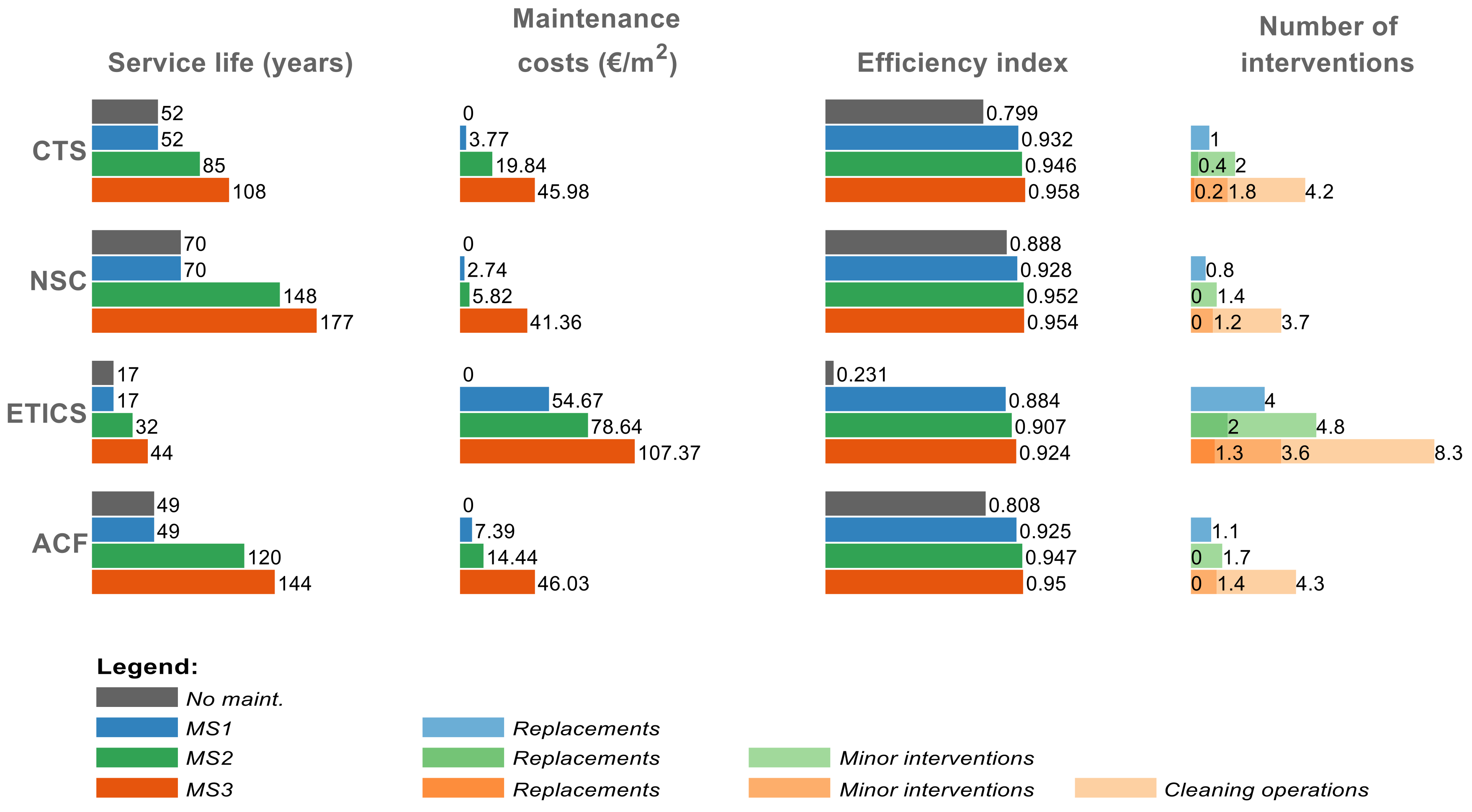
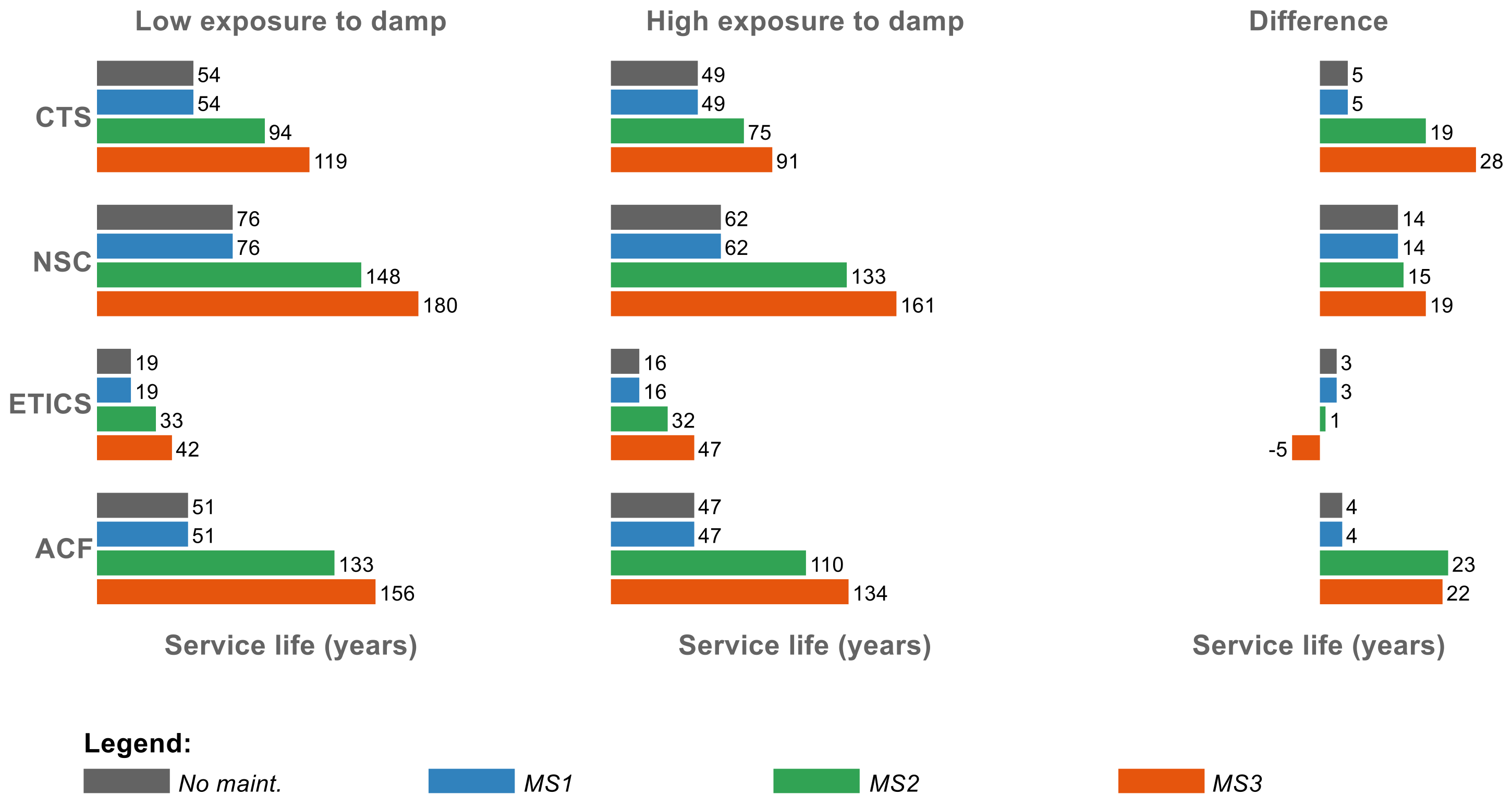
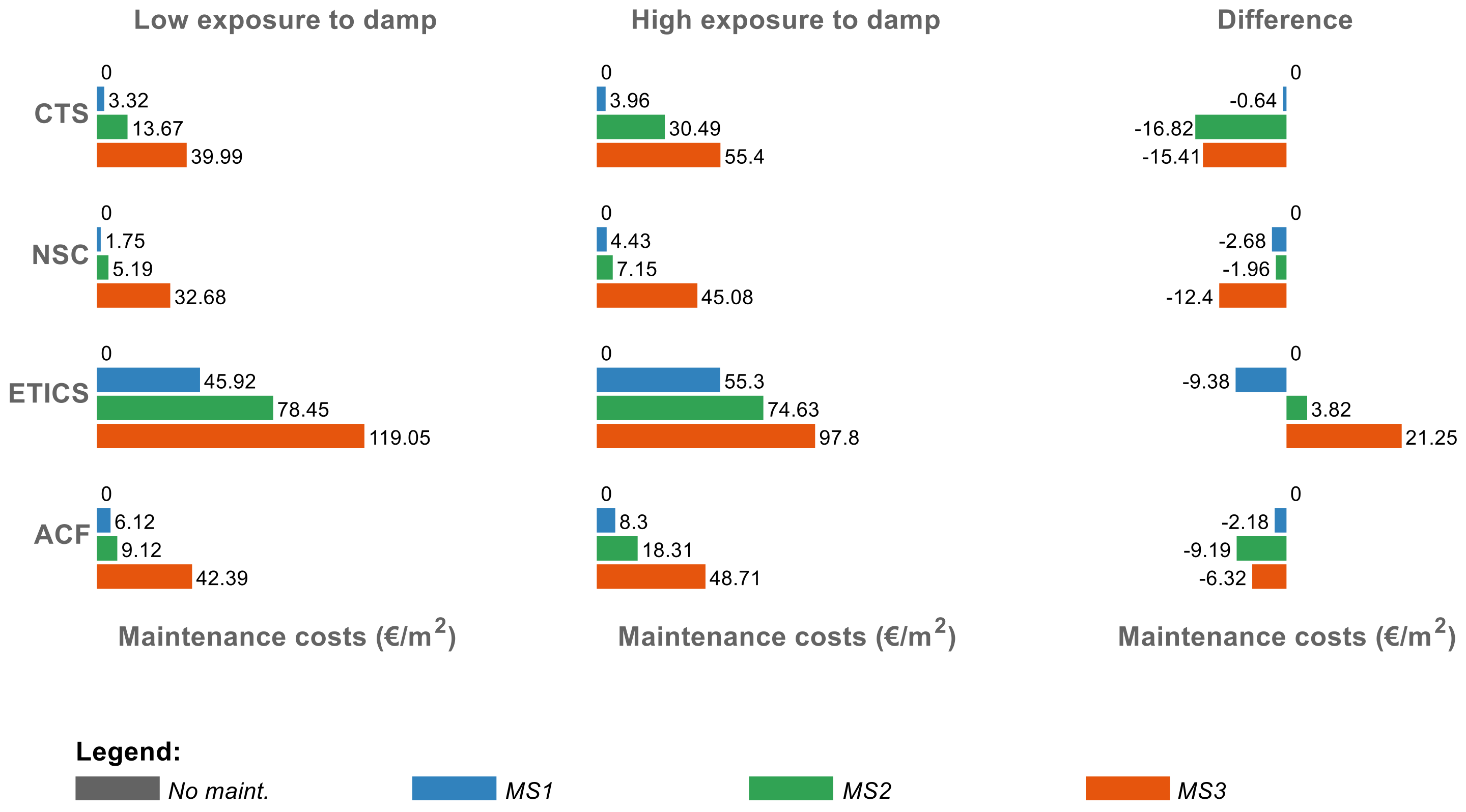
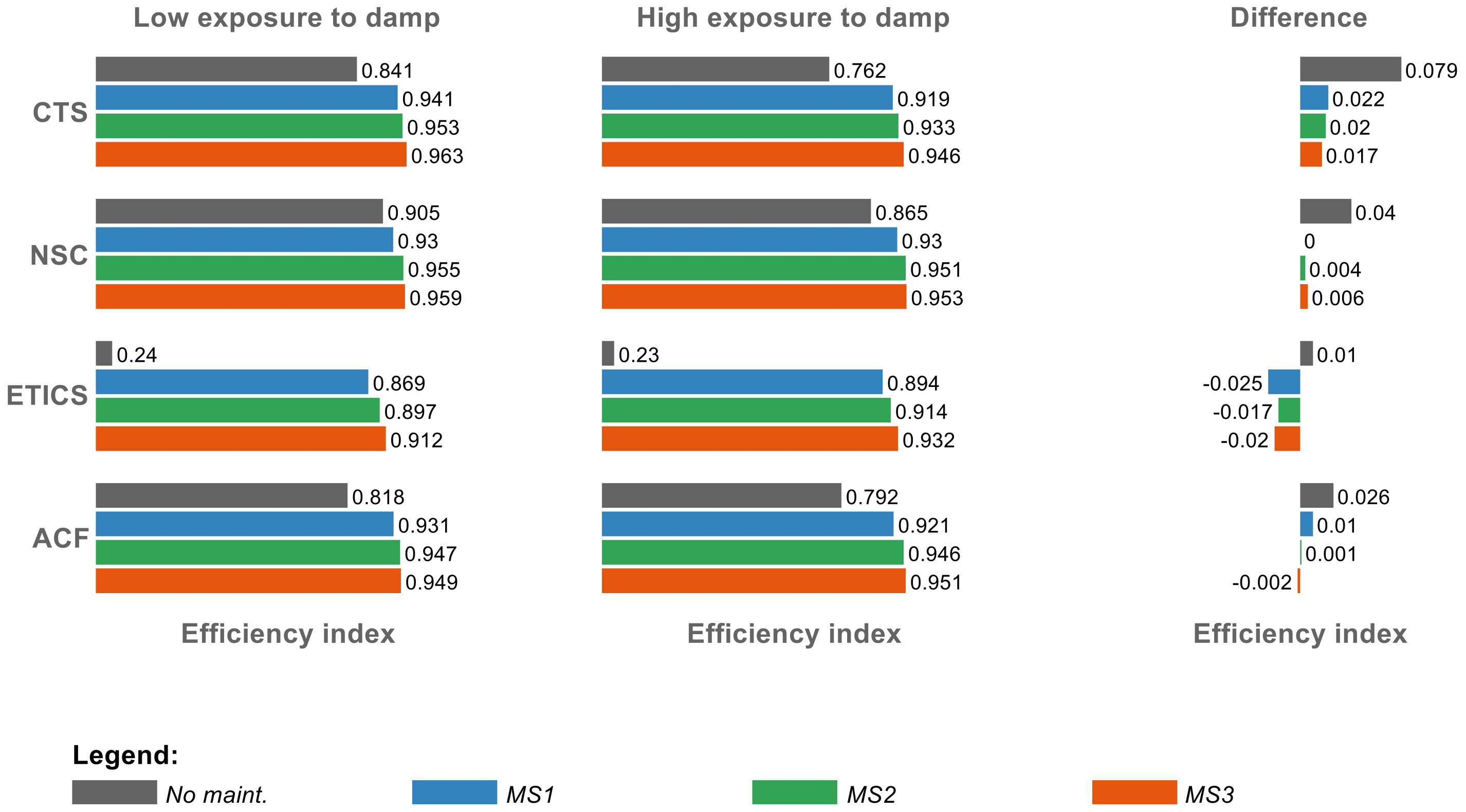
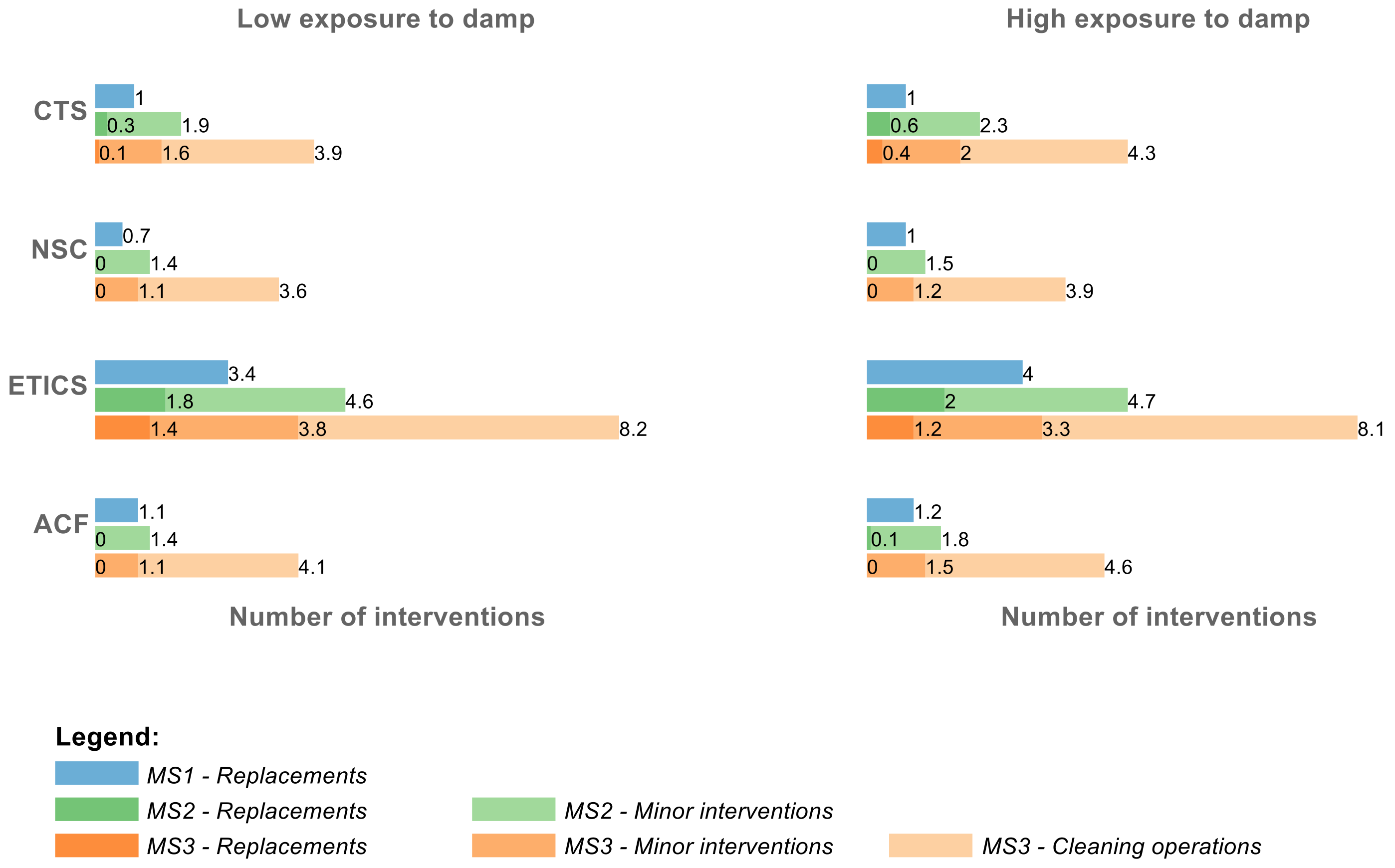
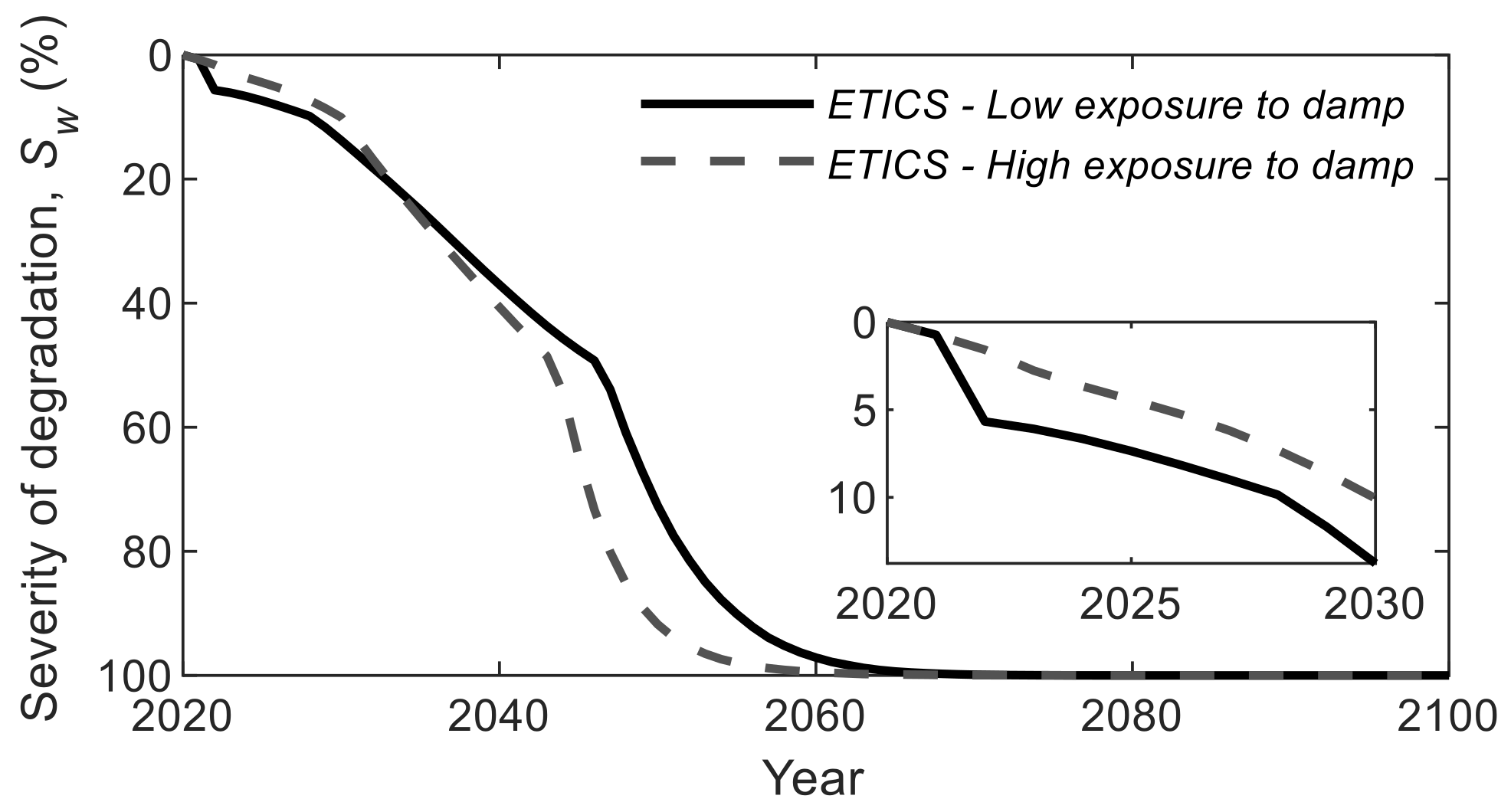
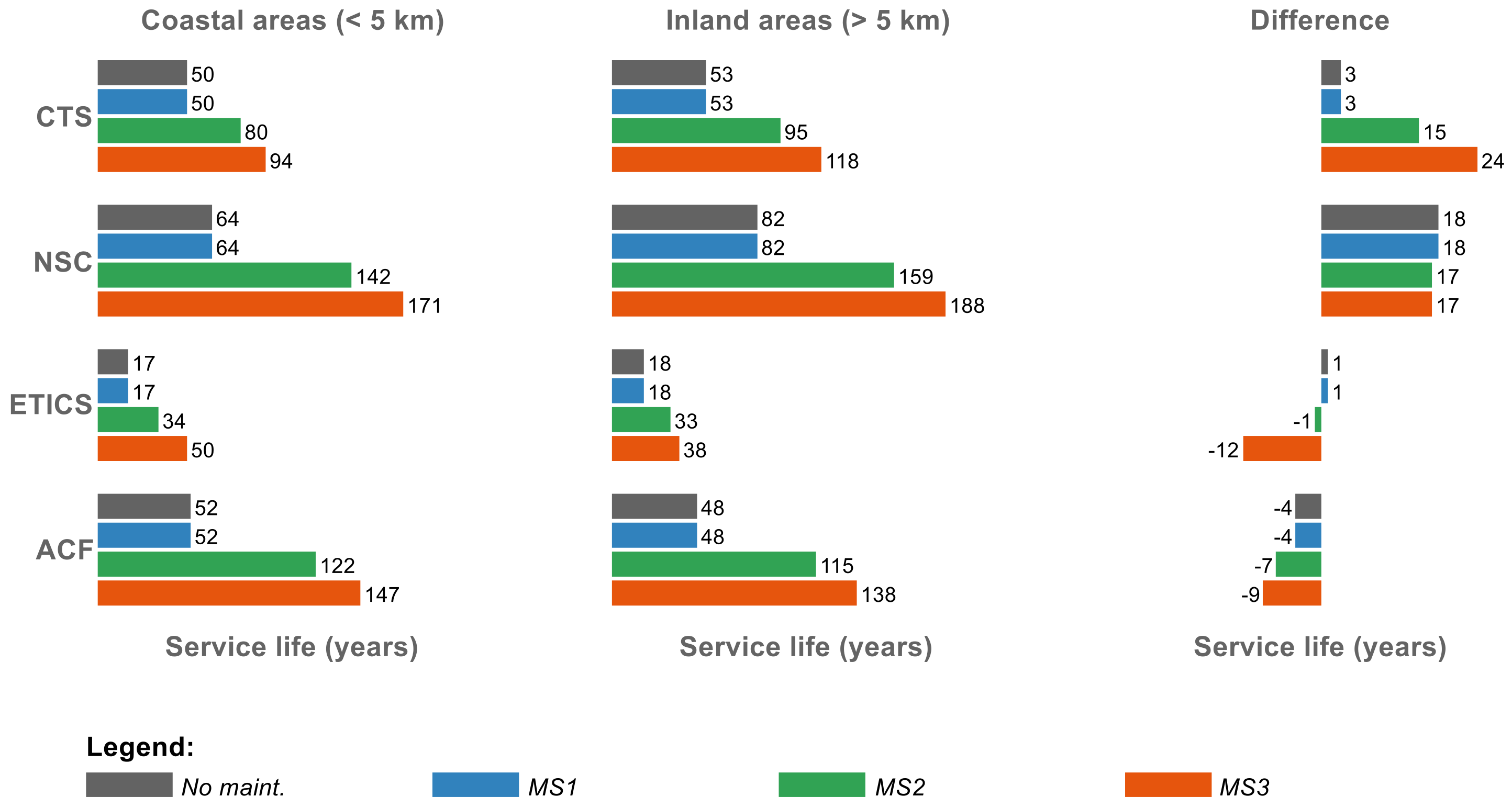

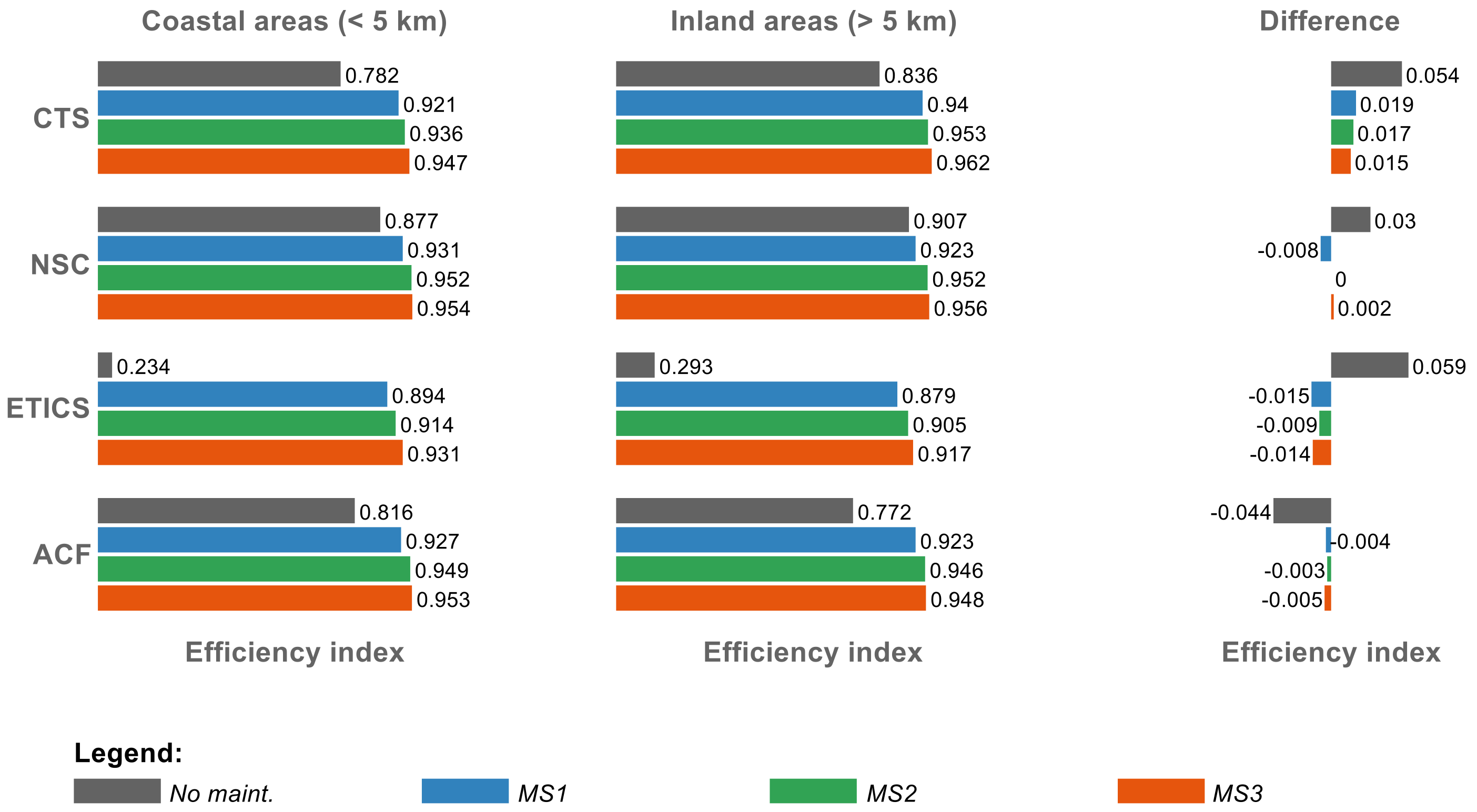

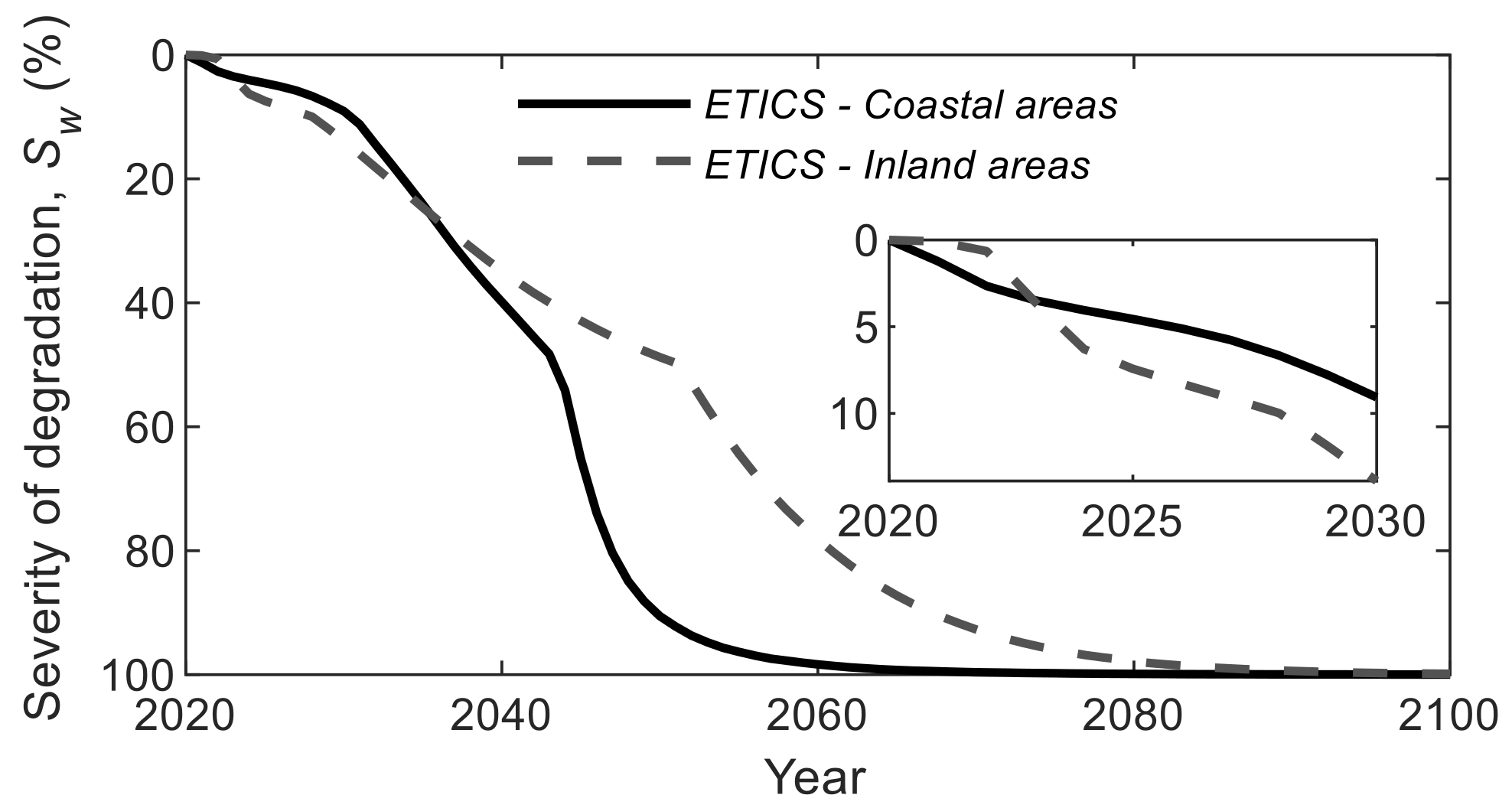
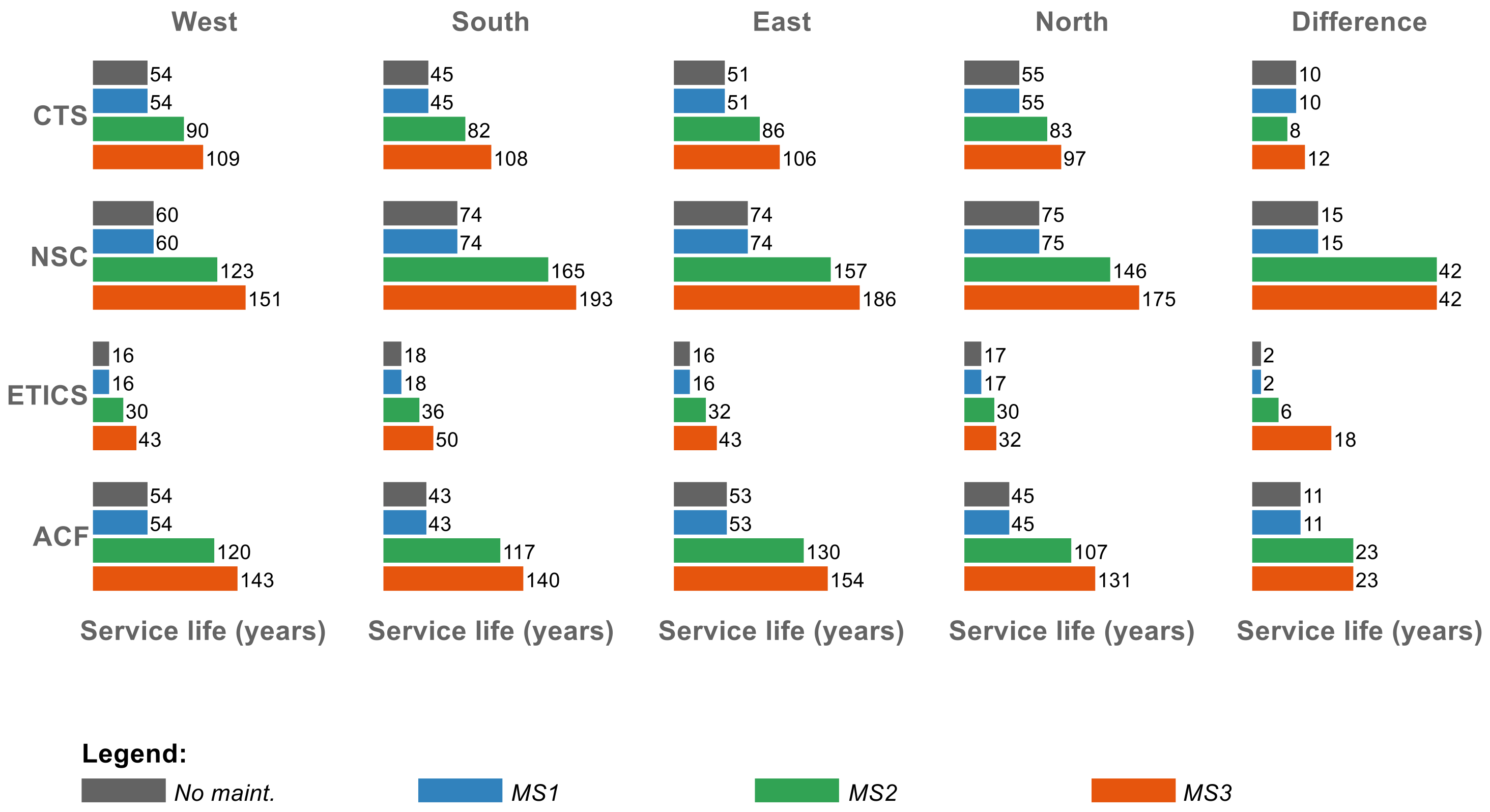

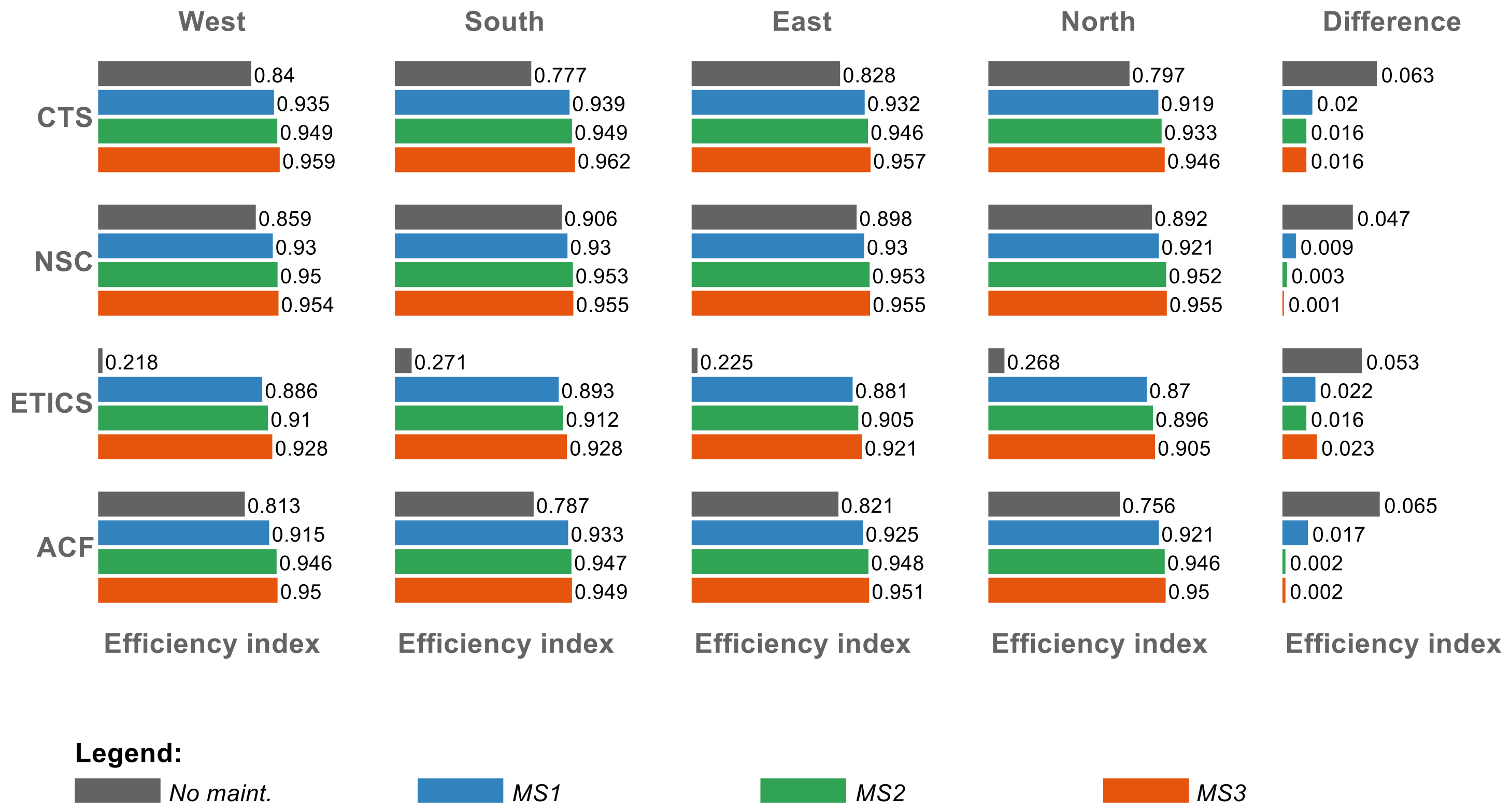

| Constructive Solutions | Environmental Exposure Conditions | Mean (Years) | Standard Deviation (Years) | |||||||
|---|---|---|---|---|---|---|---|---|---|---|
| TA | TB | TC | TD | SDA | SDB | SDC | SDD | |||
| CTS | Without impact | 6.6 | 23.6 | 22.3 | 31.6 | 6.5 | 11.5 | 1.1 | 5.0 | |
| Exposure to damp | Low | 7.2 | 28.4 | 18.4 | 53.0 | 7.6 | 9.7 | 1.1 | 2.3 | |
| High | 5.5 | 17.1 | 27.9 | 28.0 | 0.2 | 11.8 | 1.3 | 6.8 | ||
| Distance from the sea | Coastal | 4.7 | 20.2 | 27.9 | 29.2 | 3.2 | 14.2 | 2.6 | 2.0 | |
| Inland | 6.3 | 29.2 | 18.2 | 41.0 | 8.0 | 9.1 | 1.1 | 1.9 | ||
| Orientation | West | 7.4 | 26.1 | 22.5 | 49.8 | 5.3 | 17.3 | 1.3 | 2.3 | |
| South | 7.9 | 23.7 | 18.3 | 28.9 | 14.8 | 0.5 | 0.5 | 1.0 | ||
| East | 6.1 | 24.4 | 21.5 | 51.3 | 6.4 | 13.2 | 1.1 | 2.1 | ||
| North | 6.7 | 17.5 | 33.3 | 27.7 | 5.5 | 13.0 | 1.7 | 10.9 | ||
| NSC | Without impact | 4.1 | 42.9 | 22.4 | 49.9 | 7.0 | 10.3 | 1.4 | 2.4 | |
| Exposure to damp | Low | 9.6 | 39.7 | 26.3 | 50.7 | 8.1 | 9.6 | 1.3 | 2.6 | |
| High | 3.2 | 39.3 | 18.0 | 42.8 | 2.1 | 9.2 | 1.1 | 2.1 | ||
| Distance from the sea | Coastal | 3.9 | 42.0 | 18.3 | 59.3 | 6.1 | 9.2 | 1.0 | 2.4 | |
| Inland | 5.6 | 42.7 | 33.3 | 41.5 | 8.0 | 12.6 | 1.6 | 2.0 | ||
| Orientation | West | 4.4 | 35.4 | 19.1 | 49.5 | 1.2 | 9.3 | 0.7 | 2.6 | |
| South | 4.8 | 47.6 | 20.3 | 44.2 | 0.5 | 6.5 | 0.9 | 3.0 | ||
| East | 5.2 | 45.2 | 25.2 | 47.6 | 11.5 | 10.4 | 10.5 | 2.6 | ||
| North | 5.0 | 38.5 | 30.3 | 26.3 | 0.8 | 6.1 | 9.4 | 1.3 | ||
| ETICS | Without impact | 1.8 | 8.1 | 6.5 | 7.2 | 2.4 | 3.6 | 2.0 | 3.0 | |
| Exposure to damp | Low | 1.1 | 8.4 | 9.7 | 4.9 | 0.3 | 5.1 | 5.0 | 0.6 | |
| High | 2.7 | 7.9 | 5.5 | 7.2 | 3.2 | 2.4 | 1.9 | 0.8 | ||
| Distance from the sea | Coastal | 2.3 | 8.9 | 5.7 | 6.6 | 3.8 | 2.3 | 0.4 | 1.4 | |
| Inland | 2.4 | 7.7 | 8.2 | 12.8 | 0.9 | 6.3 | 3.7 | 9.5 | ||
| Orientation | West | 2.0 | 7.6 | 5.9 | 6.6 | 2.2 | 2.7 | 2.9 | 0.9 | |
| South | 1.9 | 9.8 | 6.0 | 10.4 | 3.0 | 3.2 | 0.3 | 5.7 | ||
| East | 1.4 | 8.3 | 6.7 | 6.4 | 2.9 | 4.3 | 1.3 | 3.0 | ||
| North | 2.9 | 5.5 | 9.5 | 10.5 | 0.3 | 5.8 | 4.0 | 0.7 | ||
| ACF | Without impact | 4.5 | 31.0 | 13.5 | 45.5 | 8.8 | 10.9 | 1.7 | 2.4 | |
| Exposure to damp | Low | 3.8 | 36.5 | 10.0 | 41.9 | 4.3 | 9.2 | 1.0 | 2.0 | |
| High | 5.1 | 27.0 | 15.7 | 42.1 | 11.3 | 10.0 | 5.2 | 1.8 | ||
| Distance from the sea | Coastal | 6.8 | 30.3 | 14.0 | 47.2 | 12.5 | 12.7 | 1.4 | 2.4 | |
| Inland | 3.0 | 29.9 | 14.1 | 31.3 | 3.0 | 6.8 | 2.1 | 1.6 | ||
| Orientation | West | 4.4 | 27.8 | 22.3 | 35.9 | 5.9 | 10.7 | 2.6 | 1.9 | |
| South | 3.7 | 32.8 | 6.6 | 44.7 | 7.6 | 9.3 | 1.6 | 2.0 | ||
| East | 5.4 | 33.3 | 15.8 | 42.4 | 10.5 | 14.7 | 0.8 | 1.9 | ||
| North | 4.1 | 26.8 | 14.2 | 32.5 | 7.5 | 6.5 | 1.1 | 1.9 | ||
| Constructive Solutions | Intervention | Cost (€/m2) | Application Zone Condition | Impact of the Intervention | ||
|---|---|---|---|---|---|---|
| PA (%) | PB (%) | PC (%) | ||||
| CTS | Inspection | 1.03 | All | - | - | - |
| Cleaning operation | 27.48 | B | 30.6 | 69.4 | - | |
| Minor intervention | 65.77 | C | 3.1 | 58.5 | 38.5 | |
| Total replacement | 68.85 | D, E | 100.0 | - | - | |
| NSC | Inspection | 1.03 | All | - | - | - |
| Cleaning operation | 31.37 | B | 15.0 | 85.0 | - | |
| Minor intervention | 68.80 | C | 0.0 | 80.4 | 19.6 | |
| Total replacement | 149.51 | D, E | 100.0 | - | - | |
| ETICS | Inspection | 1.03 | All | - | - | - |
| Cleaning operation | 26.88 | B | 34.9 | 65.1 | - | |
| Minor intervention | 58.13 | C | 37.3 | 30.5 | 32.2 | |
| Total replacement | 95.98 | D, E | 100.0 | - | - | |
| ACF | Inspection | 1.03 | All | - | - | - |
| Cleaning operation | 27.18 | B | 17.1 | 82.9 | - | |
| Minor intervention | 84.75 | C | 61.5 | 38.5 | 0.0 | |
| Total replacement | 106.48 | D, E | 100.0 | - | - | |
| Constructive Solution | Maintenance Strategy | Initial Costs (€/m2) | Inspection Costs (€/m2) | Maintenance Costs (€/m2) | Total Costs (€/m2) |
|---|---|---|---|---|---|
| CTS | MS1 | 55.44 | 3.89 1 | 3.77 | 63.09 |
| MS2 | 19.84 | 79.16 | |||
| MS3 | 45.98 | 105.31 | |||
| NSC | MS1 | 136.79 | 3.02 2 | 2.74 | 142.55 |
| MS2 | 5.82 | 145.62 | |||
| MS3 | 41.36 | 181.17 | |||
| ETICS | MS1 | 78.38 | 5.34 3 | 54.67 | 138.38 |
| MS2 | 78.64 | 162.36 | |||
| MS3 | 107.37 | 191.09 | |||
| ACF | MS1 | 104.54 | 3.89 1 | 7.39 | 115.82 |
| MS2 | 14.44 | 122.87 | |||
| MS3 | 46.03 | 154.46 |
| Exposure to Damp | Low | High | Low | High | Low | High | Low | High | Low | High | |
|---|---|---|---|---|---|---|---|---|---|---|---|
| Scenario | 1 | 2 | 3 | 4 | 5 | ||||||
| Criteria | Weight, λj | ||||||||||
| Efficiency index | 25% | 50% | 16.7% | 16.7% | 16.7% | ||||||
| Initial costs | 25% | 16.7% | 50% | 16.7% | 16.7% | ||||||
| Maintenance costs | 25% | 16.7% | 16.7% | 50% | 16.7% | ||||||
| Total replacements | 25% | 16.7% | 16.7% | 16.7% | 50% | ||||||
| MS | Solutions | Standardized Global Rating, xi | |||||||||
| MS1 | CTS | 0.90 | 0.96 | 0.85 | 0.74 | 0.92 | 0.97 | 0.98 | 1.00 | 0.83 | 0.89 |
| NSC | 0.48 | 0.58 | 0.56 | 0.63 | 0.00 | 0.00 | 0.72 | 0.74 | 0.65 | 0.69 | |
| ETICS | 0.00 | 0.00 | 0.00 | 0.00 | 0.10 | 0.08 | 0.21 | 0.00 | 0.00 | 0.00 | |
| ACF | 0.58 | 0.65 | 0.63 | 0.59 | 0.32 | 0.33 | 0.77 | 0.76 | 0.65 | 0.71 | |
| MS2 | CTS | 1.00 | 0.99 | 0.96 | 0.88 | 1.00 | 0.99 | 1.00 | 0.84 | 0.99 | 0.96 |
| NSC | 0.65 | 0.84 | 0.78 | 0.95 | 0.13 | 0.19 | 0.82 | 0.90 | 0.84 | 0.95 | |
| ETICS | 0.21 | 0.31 | 0.25 | 0.35 | 0.25 | 0.31 | 0.20 | 0.08 | 0.33 | 0.43 | |
| ACF | 0.77 | 0.93 | 0.81 | 0.96 | 0.46 | 0.53 | 0.88 | 0.88 | 0.91 | 1.00 | |
| MS3 | CTS | 0.97 | 1.00 | 1.00 | 1.00 | 0.98 | 1.00 | 0.87 | 0.68 | 1.00 | 1.00 |
| NSC | 0.58 | 0.68 | 0.76 | 0.89 | 0.07 | 0.07 | 0.65 | 0.54 | 0.80 | 0.87 | |
| ETICS | 0.18 | 0.43 | 0.31 | 0.57 | 0.23 | 0.39 | 0.00 | 0.00 | 0.38 | 0.59 | |
| ACF | 0.66 | 0.82 | 0.76 | 0.95 | 0.38 | 0.45 | 0.66 | 0.61 | 0.84 | 0.95 | |
| Distance from the Sea | Coastal | Inland | Coastal | Inland | Coastal | Inland | Coastal | Inland | Coastal | Inland | |
|---|---|---|---|---|---|---|---|---|---|---|---|
| Scenario | 1 | 2 | 3 | 4 | 5 | ||||||
| Criteria | Weight, λj | ||||||||||
| Efficiency index | 25% | 50% | 16.7% | 16.7% | 16.7% | ||||||
| Initial costs | 25% | 16.7% | 50% | 16.7% | 16.7% | ||||||
| Maintenance costs | 25% | 16.7% | 16.7% | 50% | 16.7% | ||||||
| Total replacements | 25% | 16.7% | 16.7% | 16.7% | 50% | ||||||
| MS | Solutions | Standardized Global Rating, xi | |||||||||
| MS1 | CTS | 0.94 | 0.89 | 0.75 | 0.83 | 0.96 | 0.92 | 1.00 | 0.97 | 0.87 | 0.84 |
| NSC | 0.56 | 0.46 | 0.63 | 0.50 | 0.00 | 0.00 | 0.75 | 0.71 | 0.68 | 0.67 | |
| ETICS | 0.00 | 0.00 | 0.00 | 0.00 | 0.08 | 0.10 | 0.02 | 0.20 | 0.00 | 0.00 | |
| ACF | 0.67 | 0.53 | 0.66 | 0.54 | 0.35 | 0.29 | 0.79 | 0.73 | 0.72 | 0.63 | |
| MS2 | CTS | 1.00 | 1.00 | 0.93 | 0.97 | 1.00 | 1.00 | 0.87 | 1.00 | 0.97 | 1.00 |
| NSC | 0.82 | 0.64 | 0.96 | 0.76 | 0.19 | 0.13 | 0.91 | 0.81 | 0.94 | 0.83 | |
| ETICS | 0.32 | 0.23 | 0.35 | 0.27 | 0.32 | 0.27 | 0.12 | 0.21 | 0.44 | 0.35 | |
| ACF | 0.94 | 0.74 | 1.00 | 0.78 | 0.54 | 0.45 | 0.92 | 0.83 | 1.00 | 0.89 | |
| MS3 | CTS | 0.95 | 0.97 | 0.99 | 1.00 | 0.96 | 0.98 | 0.63 | 0.86 | 0.97 | 1.00 |
| NSC | 0.66 | 0.54 | 0.89 | 0.73 | 0.07 | 0.06 | 0.55 | 0.60 | 0.86 | 0.78 | |
| ETICS | 0.41 | 0.18 | 0.55 | 0.31 | 0.38 | 0.24 | 0.00 | 0.00 | 0.58 | 0.37 | |
| ACF | 0.82 | 0.64 | 0.97 | 0.74 | 0.46 | 0.37 | 0.64 | 0.62 | 0.94 | 0.83 | |
| Orientation | W | S | E | N | W | S | E | N | W | S | E | N | W | S | E | N | W | S | E | N | ||
|---|---|---|---|---|---|---|---|---|---|---|---|---|---|---|---|---|---|---|---|---|---|---|
| Scenario | 1 | 2 | 3 | 4 | 5 | |||||||||||||||||
| Criteria | Weight, λj | |||||||||||||||||||||
| Efficiency index | 25% | 50% | 16.7% | 16.7% | 16.7% | |||||||||||||||||
| Initial costs | 25% | 16.7% | 50% | 16.7% | 16.7% | |||||||||||||||||
| Maintenance costs | 25% | 16.7% | 16.7% | 50% | 16.7% | |||||||||||||||||
| Total replacements | 25% | 16.7% | 16.7% | 16.7% | 50% | |||||||||||||||||
| MS | Solutions | Standardized Global Rating, xi | ||||||||||||||||||||
| MS1 | CTS | 0.93 | 0.94 | 0.91 | 0.95 | 0.82 | 0.81 | 0.81 | 0.81 | 0.94 | 0.96 | 0.93 | 0.97 | 1.00 | 1.00 | 1.00 | 1.00 | 0.89 | 0.86 | 0.86 | 0.88 | |
| NSC | 0.49 | 0.47 | 0.53 | 0.52 | 0.54 | 0.50 | 0.59 | 0.59 | 0.00 | 0.00 | 0.00 | 0.00 | 0.69 | 0.70 | 0.75 | 0.76 | 0.63 | 0.62 | 0.70 | 0.68 | ||
| ETICS | 0.00 | 0.00 | 0.00 | 0.00 | 0.00 | 0.00 | 0.00 | 0.00 | 0.08 | 0.11 | 0.06 | 0.12 | 0.04 | 0.07 | 0.10 | 0.25 | 0.00 | 0.00 | 0.00 | 0.00 | ||
| ACF | 0.56 | 0.57 | 0.61 | 0.62 | 0.49 | 0.57 | 0.60 | 0.64 | 0.30 | 0.32 | 0.32 | 0.34 | 0.73 | 0.71 | 0.78 | 0.79 | 0.68 | 0.61 | 0.70 | 0.68 | ||
| MS2 | CTS | 1.00 | 1.00 | 1.00 | 1.00 | 0.95 | 0.91 | 0.95 | 0.92 | 1.00 | 1.00 | 1.00 | 1.00 | 0.96 | 0.96 | 0.97 | 0.91 | 1.00 | 0.95 | 0.99 | 0.97 | |
| NSC | 0.67 | 0.71 | 0.72 | 0.77 | 0.78 | 0.78 | 0.83 | 0.91 | 0.14 | 0.17 | 0.14 | 0.17 | 0.80 | 0.85 | 0.86 | 0.89 | 0.84 | 0.86 | 0.88 | 0.91 | ||
| ETICS | 0.24 | 0.29 | 0.26 | 0.21 | 0.28 | 0.29 | 0.29 | 0.27 | 0.25 | 0.31 | 0.26 | 0.27 | 0.07 | 0.16 | 0.15 | 0.21 | 0.36 | 0.42 | 0.39 | 0.34 | ||
| ACF | 0.78 | 0.80 | 0.82 | 0.88 | 0.81 | 0.79 | 0.86 | 0.94 | 0.47 | 0.48 | 0.48 | 0.52 | 0.82 | 0.85 | 0.89 | 0.90 | 0.91 | 0.90 | 0.94 | 0.97 | ||
| MS3 | CTS | 0.98 | 1.00 | 0.98 | 1.00 | 1.00 | 1.00 | 1.00 | 1.00 | 0.98 | 1.00 | 0.98 | 1.00 | 0.81 | 0.79 | 0.81 | 0.81 | 1.00 | 1.00 | 1.00 | 1.00 | |
| NSC | 0.56 | 0.55 | 0.60 | 0.66 | 0.74 | 0.71 | 0.78 | 0.87 | 0.06 | 0.06 | 0.05 | 0.10 | 0.52 | 0.51 | 0.60 | 0.68 | 0.78 | 0.77 | 0.81 | 0.86 | ||
| ETICS | 0.32 | 0.32 | 0.29 | 0.14 | 0.44 | 0.41 | 0.40 | 0.29 | 0.32 | 0.33 | 0.28 | 0.22 | 0.00 | 0.00 | 0.00 | 0.00 | 0.50 | 0.51 | 0.48 | 0.33 | ||
| ACF | 0.69 | 0.66 | 0.72 | 0.79 | 0.79 | 0.73 | 0.82 | 0.91 | 0.40 | 0.38 | 0.40 | 0.45 | 0.59 | 0.55 | 0.65 | 0.72 | 0.86 | 0.83 | 0.88 | 0.93 | ||
Publisher’s Note: MDPI stays neutral with regard to jurisdictional claims in published maps and institutional affiliations. |
© 2021 by the authors. Licensee MDPI, Basel, Switzerland. This article is an open access article distributed under the terms and conditions of the Creative Commons Attribution (CC BY) license (http://creativecommons.org/licenses/by/4.0/).
Share and Cite
Ferreira, C.; Barrelas, J.; Silva, A.; de Brito, J.; Dias, I.S.; Flores-Colen, I. Impact of Environmental Exposure Conditions on the Maintenance of Facades’ Claddings. Buildings 2021, 11, 138. https://doi.org/10.3390/buildings11040138
Ferreira C, Barrelas J, Silva A, de Brito J, Dias IS, Flores-Colen I. Impact of Environmental Exposure Conditions on the Maintenance of Facades’ Claddings. Buildings. 2021; 11(4):138. https://doi.org/10.3390/buildings11040138
Chicago/Turabian StyleFerreira, Cláudia, Joana Barrelas, Ana Silva, Jorge de Brito, Ilídio S. Dias, and Inês Flores-Colen. 2021. "Impact of Environmental Exposure Conditions on the Maintenance of Facades’ Claddings" Buildings 11, no. 4: 138. https://doi.org/10.3390/buildings11040138
APA StyleFerreira, C., Barrelas, J., Silva, A., de Brito, J., Dias, I. S., & Flores-Colen, I. (2021). Impact of Environmental Exposure Conditions on the Maintenance of Facades’ Claddings. Buildings, 11(4), 138. https://doi.org/10.3390/buildings11040138










